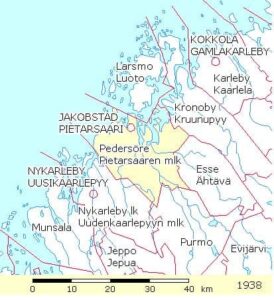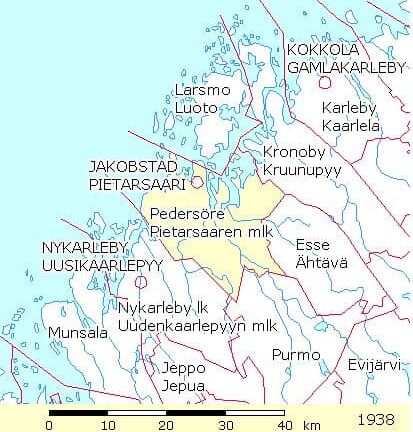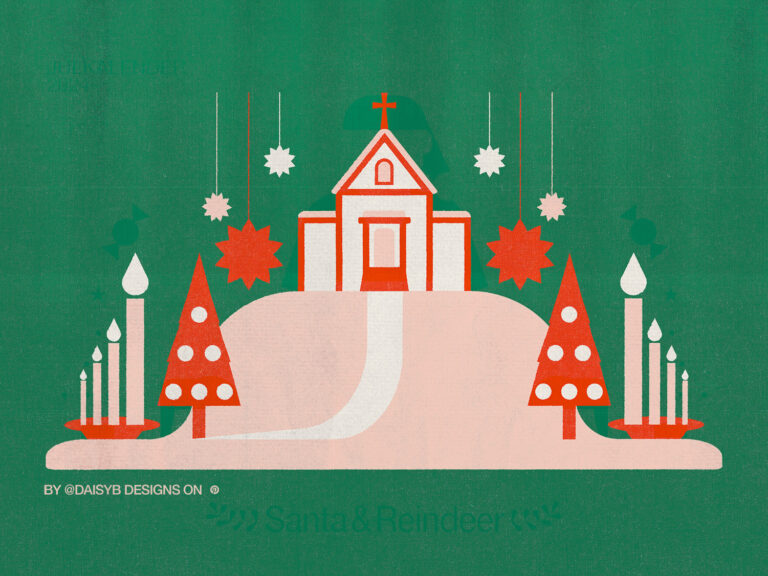By Vilhelm Sandnäs from Den Österbottniska Byn.
Translated by June Pelo.

Readers whose families emigrated from Sundby village in Pedersöre parish will enjoy the following description of life there at the turn of the century, written by a former resident of the village.
Sundby village in Pedersöre parish lies close to the big highway about 8 km south of old Pedersöre church. A present day traveler would wonder how the village got its name as his eyes can discern nothing other than the little stream that runs through the village from Kovjoki in the south. A hundred years ago when the village acquired its first buildings, it looked different. The names Sund, Näs, Fjärd and Vik which are still preserved were then a reality. As late as 1933, it was still possible during the spring floods to see that one could row a boat along the road while the entire group of farms was isolated from each other by a body of water; then one had the impression that the name of the village was well chosen.
Let us look at the village as it appeared immediately after the turn of the century. The village land consisted of a large part of meadow land which was inundated during the spring and early summer by water that formed fjärds, bays and channels. During favorable summers these low lying meadows gave a good yield in sedge and horsetail. The rural areas of the cities of Jakobstad and Nykarleby still have large acreage in Sundby. Between these spring-flooded bays and sounds lies a wood-clad neck of land and fertile acreage upon which is situated some of the most noble red-painted farms. In the middle of these acres was the largest farm Hällnäs, and at each group of farms rye grew during midsummer and in the fall there were splendid rows of tilled land as straight as an arrow.
There is a house in Sundby that is apart from its surroundings in both size and color. It is the large white 2-storied building at Gästgivars, built some time in the mid-1700’s of wood that was originally intended for Larsmo church. Because of a dispute about building a church in Larsmo, the residents were compelled to postpone work on a church, so part of the wood meant for the church was transported to Sundby and used to build a house intended for four families. The timber in the house is of an unusually coarse pine which was covered by plaster on the outside. As one of the older houses in the village, it has its own interesting history associated with the time more than 60 years ago when it was made into an inn.
People arrived in horse and carriage. The post messenger drove his own coach for which the best horses were used, and he blew into a horn to make known his arrival. High Russian officials arrived in their coaches and tossed copper coins into the mud of the yard to entertain small boys who greedily threw themselves onto the ground without thinking about getting their clothing dirty or of the delight they furnished the Russian gentlemen.
In addition to this large house in the village, there were several smaller houses near Gästgivars and not far along the main road was the Sandbacka house. South of the main road was Holländer, to the right and farther along the side road was Kristoffers and at the end near the woods was the Degernäs house. At the bend of the main road between Smedas and Pysbacka was the elementary school where J.V. Westerlund was a pioneer and Oskar Häggström continued to educate the increasing families.
West of Vannäs fjärd was the group of houses called Vannäs which gave the fjärd its name, and Kåll, on the highest hill in the village. From there one had a good view over the surroundings and one could see the high pointed church steeple of Pedersöre, also the church weather vane and bell tower. East of the Vannäs fjärd along the road was Näsebacka, known for its hunters and hounds. Farther along the same road was Svede. On the shore of the stream in the middle of the village was the Grägg house which was called Tontte and Valla, in everyday speech. At the end of Kassnäs creek there was Stor- and Lill-Kassnäs that had a roadway leading to Bennäs road.
If one went from the village to the school through Brännboa woods, it was not very pleasant in the dark. As the old people related, Ryss-Ant died on the road to Kassnäs and no one knew about it until the ravens began to gather around in a mass. At the end of Bennäs road is Hummeljut, known for its blacksmith Hummeljuts Ant.
Sundby residents are modest and reserved. All are industrious farmers who tend their farms, their cows and horses, their houses and children to the best of their ability. In this connection we cannot omit one person who meant more to the village than many others. He was Gustav Kåll who took the initiative 1898 to undertake what needed to be done and after 38 years and many difficulties, was able to see his life’s work completed.
Another person of special interest should be mentioned. Along the road to Gästgivars was a little red cottage beneath high birch and aspen trees. There lived Kådmakars-Hann (Hanna), known for her medicine in all the parishes. People brought their sick children to her; some came from long distances – from Nedervetil, Oravais and Vörå. Nearly every day some long distance visitor asked village residents where this woman lived. She learned her profession from her stepmother Kajs who used to journey all the way to Evijärvi once a week to “doctor” the pastor’s sick offspring.
If we continued along the road to Kristoffers we would see a lonely little red cottage in the pine woods. In the window we would see geraniums and myrtle, and along the cottage path wild rosebushes blossomed. Rosa Hålländer, called Ros or Sammals-Ros, lived there with her cat, her cow and her sheep, but she was often seen in the village visiting relatives and neighbors. She was the village encyclopedia. Ask her when anyone was born and you had an answer at once. Ask her anything. She was always cheerful and talkative.
The village store was at Valla. There Lisas-Fi sold 17 candy lozenges for 10 pennies and a stick of licorice for 5 pennies, also sugar, grain, material for clothing and many other things.
At Gästgivars there was a special poor couple called Ant and Hann. They lived in a little gray hut along the road. Ant fished with his net and Hann earned a few coins helping at the house and then cooked potatoes or a little grain. But she had long fingers. People knew it but pretended they didn’t. She only stole what she needed for household use. Funeral feasts were a great event for the couple. Then they had a lot of good food, and the people took up a collection for the poor. Ant and Hann were the poor and the money was given to them. But on Monday Hann was sick. She had obviously eaten too much good food. Then Ant had to walk along the road to the city to buy wine. It was not the first time. Anders and Hanna, as they called each other, went to the lemonade shop and we boys spent all our coins on lemonade that cost 20 pennies a bottle. We had many amusing times with these coins because Anders was touchy and superstitious and it was fun when he became irritated.
The water around Sundby was rich in fish and in addition to being farmers, the men fished during the spring and summer. The only fisherman by trade in the village was Skomakars-Herman, who fished mostly at Flatanabba.
The third day of Christmas was the old men’s day. The old men gathered together to discuss internal village affairs. They drank many cups of strong coffee and smoked many pipes of tobacco during the discussion.
People who married in the summer usually held a two-day wedding, while a winter wedding lasted only one day. From one of the large homes the bridal couple and the musicians rode to the bride’s home. Byggas-Vick from Östensö was the musician used most often. He was a quiet and considerate country musician who remained longer at his art than most of the others. Old bridal customs no longer remain and seldom do we see a bride with the large crown on her head. Weddings are more simplified, but a beautiful cloth on a cushion on which the bridal couple knelt is still used and everything is calm and serious.
But life was not only sun and gladness. There was often a funeral ceremony and burial. People gathered at the funeral feast at 6-7 o’clock in the morning. The aroma of spruce twigs and strong coffee drifted through the doorway. Skrädda-Mattas-Alfred would lead with his fragile voice in a hymn and the funeral guests joined in singing. Later they would return to the church and sing many comforting songs and hymns from the songbook.
This is an approximate picture of life and the people of Sundby during the turn of the century. There have been many changes and the picture we see today has changed in many ways. At the end of 1936 the entire landscape changed. Many of the people written about moved away, customs and practices changed but all the same, people continue to live there even if under new conditions, and with information to improve and preserve the best from earlier generations. May the new generation not fail.





